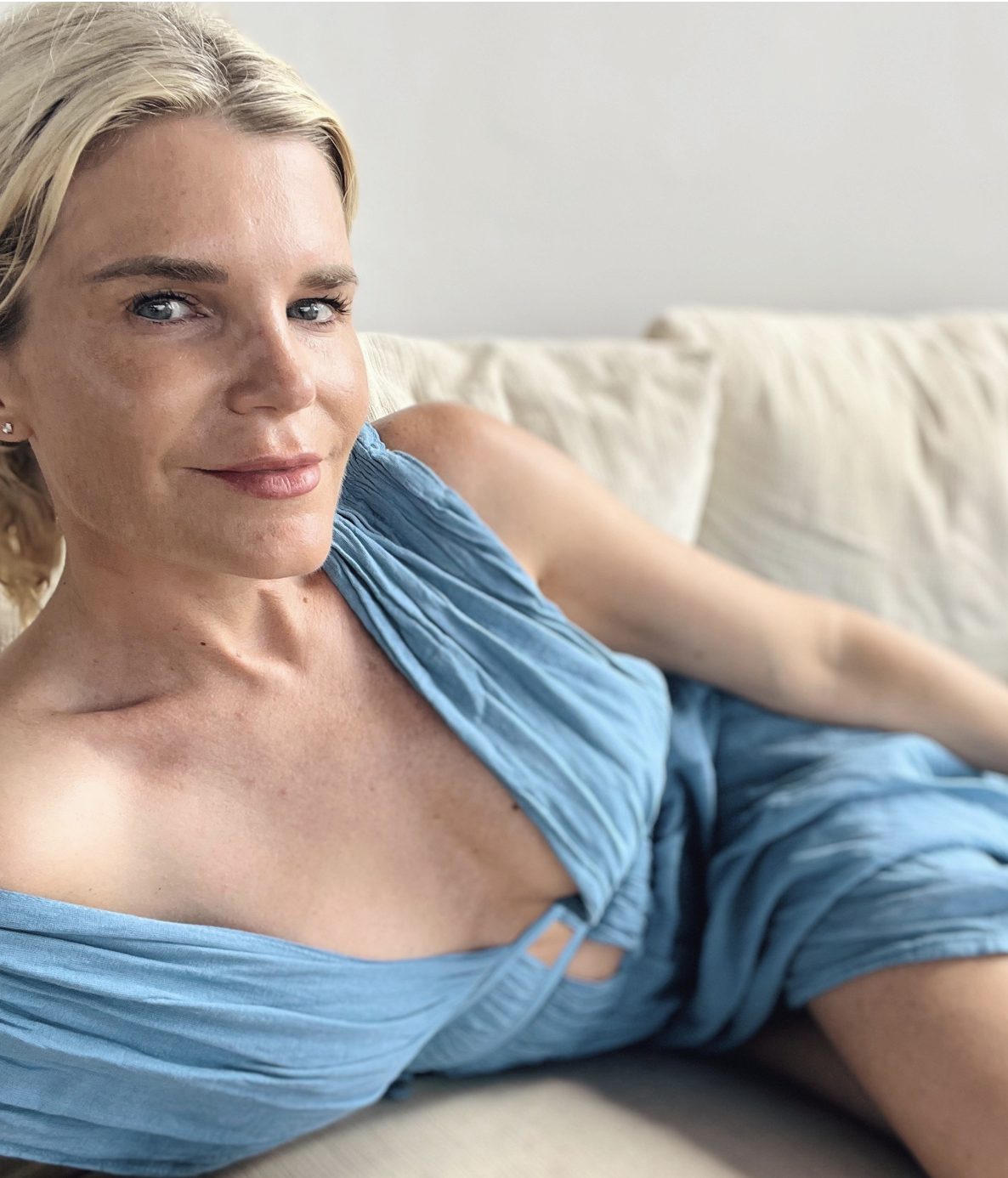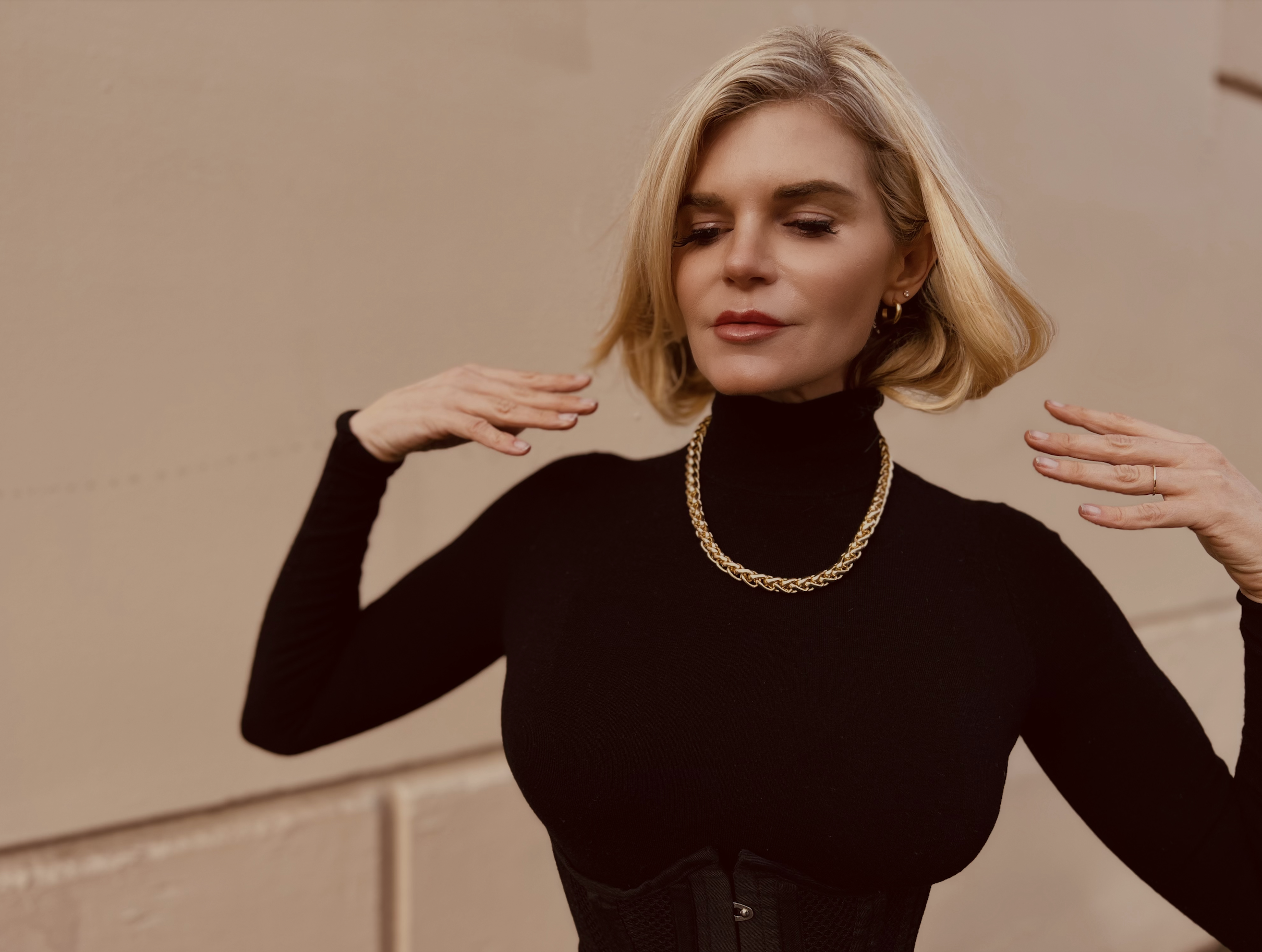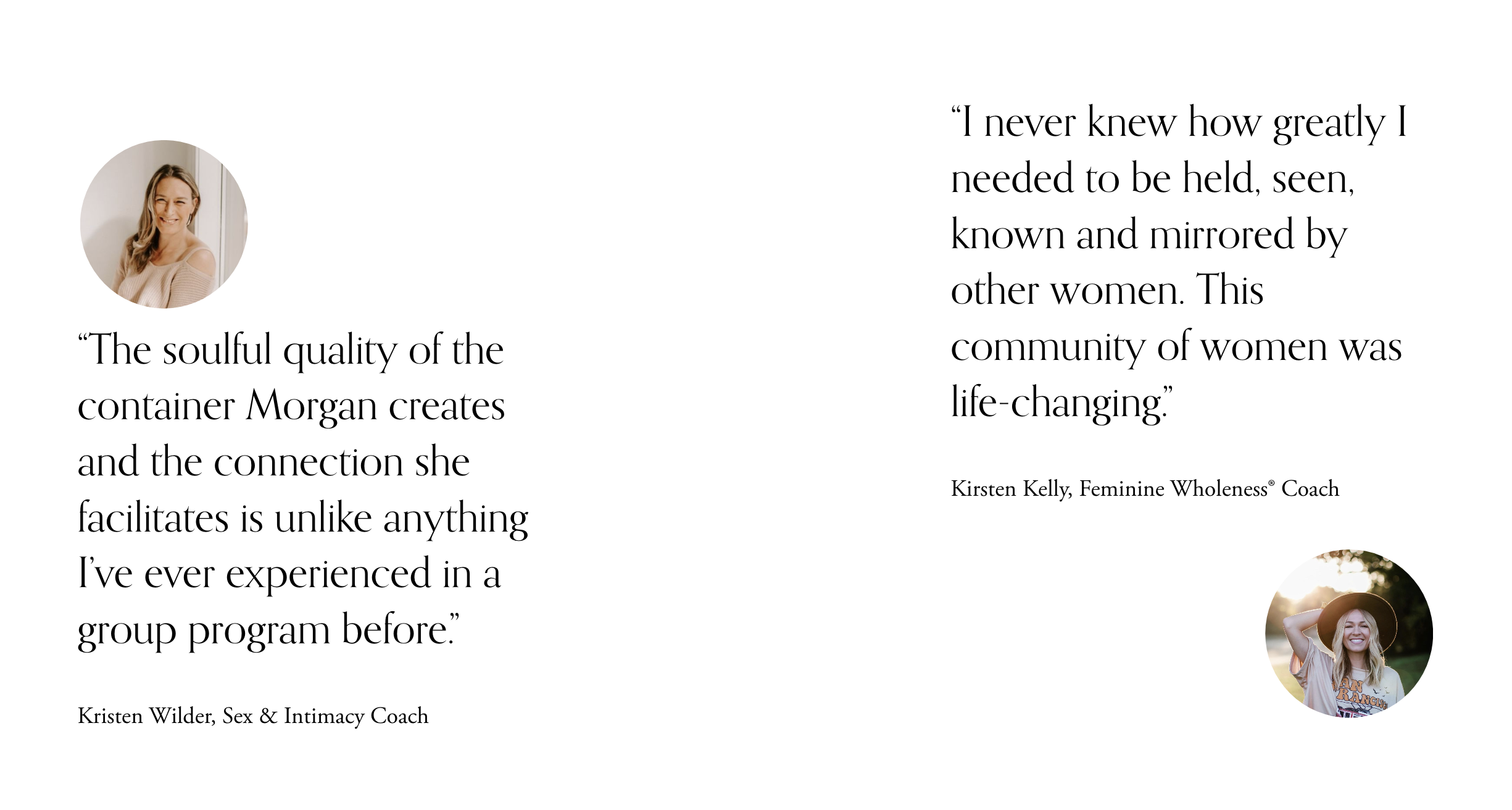Reclaiming Your Wholeness: Feminine Embodiment for Modern Women
Feminine Embodiment: My Story of Discovering & Embracing My Own Wholeness & Power
I picked up Tony Robin’s book, “Awaken the Giant Within” the summer after I turned 15. I felt as small and meek as a mouse as a teen and didn’t know what I needed, but I hoped his book could help.
Half way through reading it I decided I wasn’t going to drink alcohol for year. I was far from the legal drinking age, but “getting drunk on the weekends” was a normal routine and helped me feel less awkward among my peers.
Problem was, I was finding myself in increasingly humiliating and dangerous situations.
Giving up alcohol my junior year in high school was the first step in my discovering my own power.
My sobriety didn’t last more than the 365 days I had promised myself and it would be years before I fully discovered the source of my true power and how to embrace it.
I had no idea then how much my power was connected to my body.
I became a competitive gymnast at 10, but I didn’t become an embodied woman until my late 30s.
For most of my life my body was a source of confusion.
My body won me awards as a girl and brought me new kinds of attention when I became a woman.
It was something I learned to utilize and exploit for external validation. To perform well it needed to be disciplined, controlled and put on display.
My body didn’t become my guide and my friend until after I had put us both through hell.
Thankfully, she forgave me and we began a new journey together.
What is Feminine Embodiment?
Feminine embodiment is simply how you, as a woman, show up in the world. It’s how you experience and express yourself in and through your body, your voice, the way you dress, walk into a room, relate to and connect with others.
The desire to grow in your feminine embodiment is the natural desire. Just like the body desires health and the soul desires wholeness, the feminine desires full and unapologetic embodiment.
Core principles of Feminine Embodiment from the Feminine Wholeness® Method:
1.Embodied Safety
This looks like:
Learning how to heal your nervous system so you can create a felt-sense of warmth, belonging, goodness and security from within.
Honoring the body's wisdom: Feminine embodiment values the body's innate intelligence and cycles, such as menstruation and fertility. It seeks to reclaim the body as a source of power and pleasure rather than an object of judgment.
2. Emotional Mastery
This looks like:
Self-acceptance and self-love: Feminine embodiment is grounded in unconditional acceptance and appreciation of one's body, emotions, and feminine identity. It rejects societal pressures to conform to narrow beauty ideals or suppress emotions.
Emotional awareness and expression: Feminine embodiment involves cultivating sensitivity to one's feelings and the ability to express them authentically. It recognizes emotions as a natural part of the human experience rather than a weakness.
3. Empowered Imagination
This looks like:
Creating Your Dream Life: Using the power of your imagination to work for you instead of against you. Empowered imagination becomes possible when you learn how to align your three main wisdom centers (Head, Heart and “Honeypot” (Body). Your dreams are visions of the future and maps to healing. When you begin to pursue your dreams from your wholeness you initiate a healing journey. Remember, no matter what your current circumstances look like, are made to fulfill your dreams. When you are committed to this path, your energy can be in highest service to self and others
Another core principle of Feminine Embodiment is Interconnectedness: Feminine embodiment acknowledges the relational nature of the self and the importance of community3. It celebrates the feminine qualities of empathy, nurturance, and collaboration.
Your expression of embodied womanhood is unique to you.
There is no “one” way to embodied the feminine. Feminine embodiment is not about becoming the “it” girl. We can use feminine archetypes and icons to help us access lost or hidden aspect of our own feminine wholeness, however the goal is not to become a cookie-cutter version of anybody else.
You are not born to become a stereotype. You were born to become an icon in your own right.
This is an active process of healing from the limiting beliefs and societal conditoning that pins you to the smallest version of yourself.
When you devote yourself to your own feminine embodiment you will engage in an active process of claiming your own freedom and agency again and again and again. True feminine embodiment honors the diversity of women's experiences and rejects any notions of a single "feminine" identity.
There is not one kind of embodied woman. There are as many kinds of embodied women as their are women who dare to own who they are and express themselves in the world.
However, there is a common starting place for this journey.
We start and end with Love.
Love is the means to growth and the fullest expression of our growth in feminine embodiment.
Love, in practical terms, looks like self-acceptance, self-care, self-regard, self-love
These practices are essential because love is the only thing strong enough to break us free from the need for external validation.
As Oscar Wilde famously wrote, “To love oneself is the beginning of a lifelong romance.”
Learning to love who you are is also the beginning of living authentically.
When a woman embraces her body, her needs, her desires without shame or judgment, when she can learn to wield her emotions as a superpower, she receives the keys to her kingdom: access to her full power and potential.
Personal healing is also the starting place for collective healing, enabling each of us to begin building supportive communities. Together we are stronger and the more we simply turn our focus away from oppressive societal messages and turn towards our wholeness and gifts, the less we have to fight and resist the energies that come against.
They simply cannot touch a woman who is in her power.
Your feminine embodiment and wholeness is like a forcefield. It protects you from the negative energies of the world without you needing to fight, brace, or rely on the self-protective mechanisms learned in childhood.
History and Evolution of Feminine Embodiment
The first boy I ever loved was a passionate environmentalist and his love for the natural world taught me how to see nature and my connection to nature as a woman in new ways.
He was a ridiculously good looking senior with eyes the color of the sky and skin the color of warm earth. I was an impressionable sophomor.
Before he graduated, he gave me a book called “The Spell of the Sensuous” which I fell in love with immediately for the title alone.
The celebrated book by David Abrams invites its reader to reflect on the power of our senses and an embodied relationship with the natural and more than human world.
Little did I know at 15 that the seeds of what would become my life’s work on the beauty of embodiment for were contained in that book.
The Spell of the Sensuous weaved in the work of the French Philosopher, Maurice Merleau-Ponty's, whose phenomenological philosophy, particularly his ideas about the primacy of perception and the embodied nature of consciousness, were major influences on the modern concept of embodiment.
Though some have critiqued his work for being limited to a masculine perspective, Maurice Merleau-Ponty's ideas on embodiment and phenomenology have been influential for feminist thinkers.
The term “feminine embodiment” emerged in the 1970s and 1980s as part of the feminist movement's efforts to challenge the objectification and suppression of women's bodies.
Over the past few decades, the understanding of feminine embodiment has evolved significantly
Early conceptualizations tended to focus on reclaiming the body from patriarchal norms and celebrating universal "feminine" qualities like nurturance and intuition.
More recently, the concept has become more nuanced, recognizing the diversity of women's experiences and rejecting essentialist notions of femininity.
The emphasis has shifted towards self-acceptance, emotional expression, and the body's innate intelligence
Throughout it’s evolution, the embodied nature of consciousness and the importance of how we perceive and experience our bodies has remained.
Key figures who have shaped the idea of feminine embodiment include feminist philosophers like Simone de Beauvoir.
For Beauvoir, one becomes a woman not just because she is born female or others say she is a woman, but because she actively assumes her bodily existence in such a way. She claims and embodies herself as a woman.
The history of feminine embodiment reflects the broader feminist struggle to reclaim the female body and experience from patriarchal control. While the concept has transformed over time and will continue to evolve, the core principles of self-acceptance, emotional expression, and honoring the body's wisdom remain central.
Feminine embodiment continues to be an important framework for empowering women and resisting limiting societal stereotypes.
Maurice Merlou-Ponty’s ideas helped change the way all people, including women, think about how our bodies and our minds work together to shape our experience of the world.
To this day, when I experience my own “feminine embodiment. “ the experience feels like a sensuous spell of the nature’s timeless wisdom flowing through me.
The Impact of Feminine Embodiment on Women
Feminine embodiment has profound psychological, physical, and societal impacts on women. Depending on how a woman’s body is experienced and valued within different cultural contexts, a woman’s experience of feminine embodiment may be positive or negative.
Psychological and Emotional Effects:
Empowering and affirming of women's identity and agency.
Embodying feminine qualities like intuition, receptivity, and compassion can help women connect more deeply to their inner wisdom and spiritual source.
Feminine embodiment can be a transformative experience, particularly during key life events like puberty and menstruation.
However, in cultures and families that shame a woman’s body and function, being a woman with a female body can also be experienced negatively, leading to feelings of disempowerment, shame, and a negative self-perception that is pervasive throughout life and exacerbated by societal pressures and sterotypes.
Physical and Physiological Effects:
Women's reproductive functions and experiences, such as menstruation, pregnancy, and menopause, can significantly impact their embodied sense of self.
The medicalization and societal pressures around women's bodies and sexuality can constrain their physical agency and sexual subjectivity.
Feminist embodiment and resisting limiting stereotypes about the female body can have positive effects on women's body image and overall wellbeing.
Societal and Cultural Implications:
Feminine embodiment has been historically undervalued and suppressed in patriarchal societies, leading to an imbalance that has contributed to disconnection, violence, and disrespect for the environment.
Empowering women to embody their feminine qualities can help balance masculine and feminine energies, leading to more collaboration, nurturing, and cooperation in society.
Feminine embodiment is seen as key to women's empowerment and creating a more equitable, compassionate, and sustainable world.
Resources: A Woman’s Embodied Self by American Psychological Association
Signs and Manifestations of Feminine Embodiment
Feminine embodiment is about fully embracing and expressing your identity as a woman. Every woman’s journey to getting there is unique, but the signs of its effects are universal.
When I started to really embody my “feminine wholeness” (the term I started using to identify this conscious experience of embodying my feminine), I noticed a few big changes happening.
One big sign is that I started to feel more confident and secure in myself. I stop being as worried about what other people think - I knew my own own wort, I could feel it and sense it from the inside out, and I was making new choices that allowed me to fall asleep at night feeling proud of who you I am.
I was able to walk into a room, standing taller, making more eye contact, and feeling more comfortable in my own skin. I started experimenting with taking up more “space” both online and off.
Another sign is that I started to really appreciate the special qualities that make me a woman. Things like my sensitivity. For instance, instead of calling my emotions a “liability” I started referring to them as one of my “superpowers.”
I also started intentionally dedicating a meaningful portion of my nurturing nature to my own nurturing, i.e learning how to re-mother myself and take supremely good care of the four self-care basics for women of 1. Nourishment 2. Sleep 3. Rest and 4. Pleasure.
I stopped trying to hide the more “creative” parts of myself and instead started celebrating what I once thought of as my “weirdness” as strengths.
For instance, my love for feminine icons and archetypes, playing dress up and shooting self-photography.
One of the biggest shifts for me was feeling more grounded and connected to my body, and intentionally seeing my yoga practice and workouts as an opportunity to cultivate that.
Instead of seeing my body as something to be controlled or fixed, I started to see her as a source of power and wisdom. I paid attention to the natural rhythms and cycles of your body, and I began treating these internal rhythms with care and respect.
I also totally reframed my moon cycles and began honoring my intuition and intuitive hits instead of disregarding what my body knew or trying to downplay it to avoid conflict or difficult decisions.
The women I have coached have experienced these milestones, too.
What consistently amazes me is how graceful and simple it is for a woman to find her way home to herself when she finds this path. Even after years or decades of talk-therapy.
There is just something about feminine embodiment work that is the short-cut back to wholeness and personal power.
Overall, feminine embodiment is about honoring all the amazing things that make you a woman. It's about letting go of societal pressures and expectations, and instead, embracing your full, authentic self.
When you do that, no matter what is going on in your life, or how far from yourself you feel like you have become, you'll start to radiate a new confidence, grace, and inner peace. And it won’t just be the people around you who notice– you will notice yourself as a new woman too.
It's a really beautiful transformation to go through, and it can have a profound impact on every area of your life. Your soul has lead you here for a reason. And by trusting the nudge that lead you to my work, you are already leaning into your femininity. Congratulations, my love. It's a gift that deserves to be celebrated!
Cultivating Feminine Embodiment & Healthy Self-Image
As a feminine embodiment coach, one of the first areas I guide my clients through are powerful practices to cultivate a healthy self-image to deepen their connection to their feminine essence.
Some specific ways you can support yourself on this journey:
Practicing self-care and self-nurturing activities
Regular self-care rituals that honor their bodies and nourish their souls include:
Mindful movement practices like gentle yoga, dance, or walking in nature
Pampering yourself with nourishing skincare routines, warm baths, and self-massage
Learning the simple Healing Sensuality Essentials to experience more bliss in your body.
Journaling to process emotions and cultivate self-compassion
Preparing and savoring nourishing, whole foods
The most important aspect of this practice is to tune into your body's needs and treat yourself with the same tenderness as you would give to your child or dear friend.
2. Exploring creative outlets for self-expression
Creativity is a healing pathway to self-expression and embodying the feminine. Whether you choose painting, drawing, writing poetry or short stories, dancing, singing, or playing music, or crafting, gardening or other handwork, the benefits are huge.
By engaging the right brain through creative play you can bypass the inner critic and access deeper wells of wisdom, joy, and self-acceptance.
My signature way of helping my clients explore and expand self-expression is through self-photography.
My own journey into healing my feminine wounds and becoming more embodied as the woman I desired to be began with a single self-portrait.
I was 26, single and 8-months pregnant. I felt completely unwanted as a woman, unlovable and disqualified from the life of my dreams. I was drowning in shame and unworthiness.
Then one day I got creative, dressed up as Marilyn Monroe, and took out my camera. I tapped into the feminine energy of an icon I adored for her playfulness and sex appeal.
I began to feel better. Through the lens of my camera and my own creativity I saw myself with new eyes.
I’ve helped 1000+ students do the same through a process I call “Healing Your Own Gaze.”
This is something I am so passionate about, so allow me to get a little fiery…
Digital marketing experts estimate that most Americans are exposed to around 4,000 to 10,000 ads each DAY.
Compound that with the number of social media posts we are scrolling through and the number of images we see every day is staggering!
Now more than ever it’s important to be aware of the effect images from ads and social media have on how we see ourselves as women.
Let me ask you this: do you see yourself or your likeness in the majority of these images? Do the images in your feed inspire you to explore and express your sexuality and spirituality in ways that feel authentic to YOU?
Or do they send the subtle message that you, or the way you look, think, feel don’t really count?
The problem isn’t with any one representation of womanhood, it’s the LACK OF VARIETY, DIVERSITY, UNIQUE EXPRESSION. The power is literally in our hands to change this!
The images we behold hold power over us.
It’s happening below the level of your conscious mind. It's constructing your SELF-IMAGE—the most important factor on your level of health, happiness and success, according to psychologists.
Images also affect your sacred inner eye—your ability to recognize your own soul.
For most women the effect of the is negative and it’s only getting worse. Self-esteem and a sense of worthiness and connection is plummeting even as our technology advances.
This doesn’t just play out in daily consequences to our mood, this plays out in long-terms ways for our daughters and our own potential.
Now hear this:
YOU ARE NOT POWERLESS.
If you feel the damaging effects of not being able to accept yourself or own all of who you are as a woman;
if you are beginning to wake up to the blocks in your own unconscious mind affecting your feminine self-image,
if you are starting to see how deep this rabbit hole goes and how much your distorted view of self is holding you back from the life, love and impact you want to have in the world, join me in healing your own gaze.
3. Surrounding yourself with a supportive community
The journey of feminine embodiment and wholeness is the ongoing work of your lifetime. It’s profound and challenging work and you are not meant to do it alone.
It’s so important to be part of a circle of supportive women on a similar path. This could include:
Joining a women's circle, book club, or other group
Attending workshops, retreats, or other immersive experiences
Connecting with online communities focused on feminine embodiment
Seeking out role models and mentors further along the path
If you are ready for the intimate support, guidance of a coach to witness and mirror back to you the wholeness and happiness you are made for, it would be my honor to walk with you on this journey.
1:1 coaching provides a customized roadmap for your healing and success and offers invaluable encouragement, accountability, and inspiration to help you overcome obstacles and achieve breakthroughs faster than going at it alone by helping you see your blindspots and address the unconscious blocks holding you back.
Journaling prompts for feminine embodiment coaches and practitioners:
1. What does it mean to embody the feminine?
2. What are the benefits of feminine embodiment?
3. How can I cultivate more feminine energy in my life?
4. What practices or exercises can help me get in touch with my feminine essence?
5. How does feminine embodiment relate to self-love and body acceptance?
6. What role does sexuality play in feminine embodiment?
7. How is feminine embodiment different from traditional feminine gender roles?
8. Are there any retreats, workshops or courses focused on feminine embodiment?
9. What does feminine embodiment look like in relationships or dating?
10. How can feminine embodiment empower women in the workplace or other areas of life?
11. Are there any books, podcasts or other resources about feminine embodiment?
12. What is the spiritual or energetic aspect of feminine embodiment?
13. How can feminine embodiment practices help with stress, anxiety or other mental health issues?
14. What's the difference between feminine embodiment and feminist ideology?
15. How can men embrace or understand feminine embodiment in a respectful way?
















